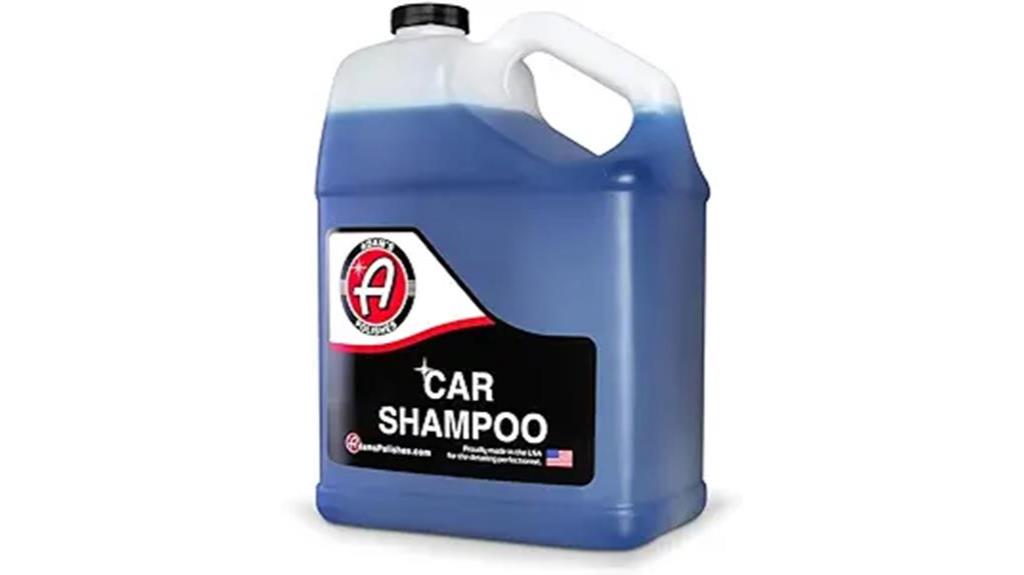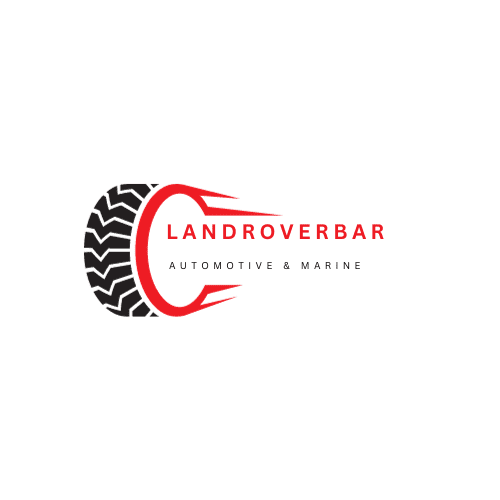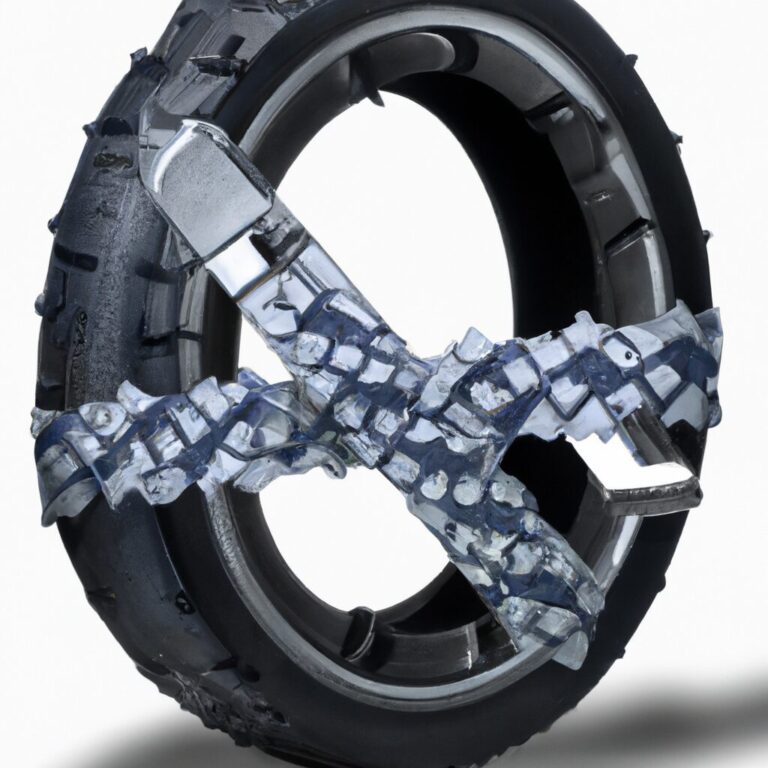10 Best Car Wash Soaps for Pressure Washers to Keep Your Ride Shining
When it comes to keeping your ride gleaming like a diamond under the sun, choosing the right car wash soap for your pressure washer is key.
But with a plethora of options out there, how do you ensure you're picking the best one to make your car sparkle effortlessly?
Let's explore the top 10 car wash soaps that are tailor-made for pressure washers, each offering unique benefits to elevate your car washing game.
Key Takeaways
- Choose car wash soaps with proper concentration levels for effective cleaning.
- Consider paint compatibility and environmental impact when selecting a soap.
- Use appropriate application methods like foam cannons for optimal results.
- Look for biodegradable options with thick suds for a gentle yet thorough wash.
Chemical Guys Sticky Snowball Ultra Snow Foam Car Wash Soap (64 fl oz, Cherry Scent)

If you're looking for a highly effective and pH-balanced car wash soap that maximizes contact time to remove dirt and grime, the Chemical Guys Sticky Snowball Ultra Snow Foam is the ideal choice for both beginners and professionals. This concentrated car wash soap creates thick suds that stick to surfaces, ensuring effective cleaning. It's safe for all exterior automobile parts due to its pH balanced formula. Only 1-3 ounces of this concentrated formula are needed for a 5-gallon wash bucket or foam cannon, making it a cost-effective option.
Whether you prefer foam cannons, guns, or bucket washes, this product is versatile. Made in the USA by Chemical Guys, this product has garnered positive user feedback for its ease of use, effectiveness, and pleasant cherry scent.
Best For: Car enthusiasts and professionals seeking a highly effective and pH-balanced car wash soap that maximizes contact time to remove dirt and grime.
Pros:
- Produces thick suds that stick to surfaces for effective cleaning.
- pH balanced formula safe for all exterior automobile parts.
- Versatile for use with foam cannons, guns, or bucket washes.
Cons:
- Requires 1-3 ounces for a 5-gallon wash bucket, may run out quicker with frequent use.
Chemical Guys Extreme Bodywash & Wax Foaming Car Wash Soap (64 fl oz)

For those seeking a foaming car wash soap that effectively cleans vehicles while adding shine and protection, the Chemical Guys Extreme Bodywash & Wax is an ideal choice. This 64 fl oz product is suitable for cars, trucks, motorcycles, and RVs. Available on Amazon since 2010 with over 14,000 ratings, this soap produces thick foam to clean vehicles and can be used with a bucket, foam gun, or foam cannon. Made in the USA, it's beginner and professional detailer-friendly, pH balanced, and safe for all exterior automobile parts. With a pleasant grape scent and blended with natural carnauba wax and a synthetic wax for durability, this concentrated soap requires only 1-3 oz. for a 5-gallon wash bucket or a 32 oz. solution tank.
Best For: Those looking for a versatile and effective foaming car wash soap that provides thorough cleaning, shine, and protection for their vehicles.
Pros:
- Produces thick foam for effective cleaning.
- Pleasant grape scent adds to the washing experience.
- Blended with natural carnauba wax and synthetic wax for enhanced durability.
Cons:
- May require more frequent application for heavily soiled vehicles.
Adams Car Wash Shampoo (Gallon)

With its pH neutral formula and slick, scratch-free wash, Adams Car Wash Shampoo (Gallon) is the ideal choice for those seeking a safe and effective cleaning solution for all vehicle surfaces. This product offers a thick layer of suds that helps in removing dirt while being safe for all vehicle exteriors. The spot-free formula ensures it won't strip waxes or coatings, maintaining your vehicle's shine. Customers have praised its concentrated formula for being long-lasting, providing excellent lubrication, and leaving no residue behind. Suitable for foam cannons, snow foam, and pressure washing, Adams Car Wash Shampoo is versatile and suitable for all vehicle types. Its gentle pH neutral nature makes it perfect for use on various surfaces, including those with ceramic coatings.
Best For: Those looking for a pH neutral, safe, and effective car wash shampoo suitable for all vehicle types.
Pros:
- pH neutral formula safe for all vehicle surfaces
- Thick layer of suds for effective dirt removal
- Spot-free formula that won't strip waxes or coatings
Cons:
- May not produce as much foam as some other car wash shampoos
Rain-X Deep Cleaning High Foaming Soap (48 fl oz)

Ideal for those seeking a deep cleaning foam car wash solution that effortlessly removes dirt and debris without the need for hand drying, Rain-X Deep Cleaning High Foaming Soap stands out as a top choice in the realm of car wash soaps for pressure washers. This environmentally conscious formula is safe, biodegradable, and pH balanced, ensuring a spot-free shine without stripping wax. With its concentrated formula requiring only 1oz per gallon of water, it saves time and effort. Following the directions to wash in the shade, apply the soapy water, and rinse off thoroughly will result in professional-grade cleanliness. Rain-X, a trusted brand for superior car cleaning products, delivers a high foaming soap that leaves your vehicle spotless with ease.
Best For: Those looking for a time-saving, environmentally conscious car wash soap that provides a spot-free shine without the need for hand drying.
Pros:
- Environmentally conscious, safe, biodegradable, and pH balanced formula.
- Concentrated formula requires only 1oz per gallon of water, saving time and effort.
- Leaves a spot-free shine without stripping wax, promoting professional-grade cleanliness.
Cons:
- Some users have experienced streaks on glass and found the need for additional drying.
Meguiars Gold Class Car Wash, Ultra-Rich Foam Soap and Conditioner (1 Gallon)

Looking to effortlessly clean and condition your car while preserving its wax protection? Meguiars Gold Class Car Wash, Ultra-Rich Foam Soap and Conditioner (1 Gallon) is the perfect solution for you. This advanced formula simplifies the car cleaning process by combining cleaning and conditioning into one easy step. The biodegradable formula creates powerful suds that effectively remove tough dirt and contaminants, while also preserving the existing wax protection on your vehicle.
With ultra-rich paint conditioners, this car wash leaves your car's surface looking radiant and revitalized. Whether you prefer using a foam cannon or the traditional bucket-and-sponge method, Meguiars Gold Class Car Wash delivers exceptional cleaning and conditioning results every time. Trust in this product to keep your ride shining bright.
Best For: Car owners who want a convenient and effective car wash solution that combines cleaning and conditioning in one step.
Pros:
- Simplifies car cleaning process by combining cleaning and conditioning.
- Preserves existing wax protection on the vehicle.
- Leaves the car's surface looking radiant and revitalized.
Cons:
- May be a bit pricey compared to other car wash products.
Sun Joe Premium Snow Foam Car Wash Soap & Cleaner, 1 Gallon

For those seeking a versatile and biodegradable car wash soap that's safe for both metal surfaces and wax or sealants, the Sun Joe Premium Snow Foam Car Wash Soap & Cleaner, 1 Gallon is an excellent choice. This pressure washer concentrate formula effectively removes dirt and grime while maintaining the integrity of your vehicle's wax and sealants. Safe for use on various surfaces like wood and brick, this product offers a pleasant orange-vanilla scent for an enjoyable cleaning experience. Designed for use with a pressure washer foam cannon attachment, such as the Sun Joe SPX-FC34, this car wash soap provides a thorough and gentle cleaning solution. With positive user reviews praising its effectiveness and ease of use, the Sun Joe Premium Snow Foam Car Wash Soap & Cleaner is a top contender for keeping your ride shining.
Best For: Car owners looking for a biodegradable car wash soap that's safe for metal surfaces and wax or sealants.
Pros:
- Biodegradable formula
- Safe for wax and sealants
- Versatile application on various surfaces
Cons:
- Requires a pressure washer foam cannon attachment for optimal use
Kärcher Car Wash & Wax Cleaning Soap Concentrate – 1 Gallon

When choosing a car wash soap for your pressure washer, consider the Kärcher Car Wash & Wax Cleaning Soap Concentrate – 1 Gallon for its highly concentrated formula that can make up to 20 gallons of detergent from a single gallon. This eco-friendly, biodegradable soap is designed to work with most consumer gas and electric power pressure washers, providing a universal compatibility advantage.
Made in the USA, this product ensures a perfect car wash system that leaves no residue behind, maintaining a streak-free finish. The Kärcher Car Wash & Wax Cleaning Soap Concentrate isn't only compatible with all Kärcher Home & Garden pressure washers but also offers a convenient solution for washing cars, trucks, boats, RVs, furniture, heavy equipment, and more.
Best For: Ideal for car owners looking for a highly concentrated, eco-friendly car wash soap that works effectively with most consumer gas and electric power pressure washers.
Pros:
- Universal compatibility with most pressure washer brands.
- Highly concentrated formula that makes up to 20 gallons of detergent.
- Eco-friendly and biodegradable, leaving no residue.
Cons:
- Some users may experience streaking under certain conditions.
Armor All Car Cleaning Wash, All Purpose Car Wash Soap (1 Gallon)

With its gentle formula that protects wax and delivers streak-free results, Armor All Car Cleaning Wash, All Purpose Car Wash Soap (1 Gallon) is the go-to choice for those seeking a safe and effective cleaning solution for all vehicle surfaces. This foaming soap creates thick suds that effectively lift dirt and grime without stripping your vehicle's wax coat. Safe for use on all surfaces, this soap ensures a spotless finish every time you wash your car. Manufactured by Armored Auto Group Sales Inc, this Armor All product weighs 8.86 pounds and comes in a convenient 1-gallon size. Customers have praised its performance and value, with some providing feedback on potential improvements and packaging suggestions. If you're looking for a reliable car wash soap that won't disappoint, Armor All Car Cleaning Wash is a solid choice.
Best For: Those looking for a gentle yet effective car wash soap that protects wax and provides streak-free results.
Pros:
- Gentle formula that won't strip wax
- Thick suds for lifting dirt and grime effectively
- Safe for use on all vehicle surfaces
Cons:
- Potential improvements suggested by some customers
Armor All Ceramic Foaming Car Wash Soap, 1 Gallon

For those seeking a car wash soap that not only cleans but also provides long-lasting protection, the Armor All Ceramic Foaming Car Wash Soap, 1 Gallon, is an ideal choice. This product comes in a 1-gallon bottle and is formulated with hydrophobic Extreme Shield and ceramic technology. It creates an invisible protective barrier that enhances water beading, helping to repel dirt and contaminants from sticking to your car's surface. When used with the Armor All foam cannon, it produces a snow foam effect for thorough cleaning. Users have reported that this car wash soap delivers an amazing glossy look with a candy apple appearance while effectively creating a protective barrier. Keep in mind to follow proper application and drying techniques to avoid water spots and streaks. Recommended for maintenance washes and additional protection against contaminants.
Best For: Car owners looking for a car wash soap that not only cleans effectively but also provides long-lasting protection against dirt and contaminants.
Pros:
- Formulated with hydrophobic Extreme Shield and ceramic technology for enhanced water beading
- Creates an invisible protective barrier to repel dirt and contaminants
- Delivers an amazing glossy look with a candy apple appearance
Cons:
- Needs to be used carefully to avoid water spots and streaks
Chemical Guys Mr. Gold Foaming Car Wash Soap (64 fl oz, Pina Colada Scent)

Ideal for both beginners and professionals, the Chemical Guys Mr. Gold Foaming Car Wash Soap stands out with its concentrated formula and pleasant Pina Colada scent, making it a top choice for those seeking effective and enjoyable vehicle cleaning.
This foaming car wash soap by Chemical Guys is designed to produce thick foam bubbles that clean vehicles effectively, suitable for various types of vehicles including cars, trucks, motorcycles, and RVs. Whether you prefer using foam cannons, foam guns, or traditional bucket washes, this soap is versatile and can be used with ease.
The pH-balanced formula is safe for all exterior automobile parts and works well on all automotive paint colors. Made in the USA, this soap offers a refreshing Pina Colada scent to enhance your washing experience.
Best For: Those looking for a versatile, effective, and pleasantly scented car wash soap suitable for various types of vehicles.
Pros:
- Produces thick foam bubbles for effective cleaning
- Safe for all exterior automobile parts
- Refreshing Pina Colada scent enhances washing experience
Cons:
- Some users find the foam duration to be shorter than expected
Factors to Consider When Choosing Car Wash Soaps for Pressure Washer
When selecting car wash soaps for your pressure washer, you should consider factors like:
- Soap concentration levels
- Application methods
- Paint compatibility
- Environmental impact
- Scent preferences
These elements play a crucial role in determining the effectiveness and safety of the soap for your vehicle.
Taking these factors into account will help you choose the right product for a successful car wash experience.
Soap Concentration Levels
Consider the soap concentration levels when selecting car wash soaps for your pressure washer to ensure efficient and cost-effective cleaning. Soap concentration determines the amount of product needed for effective cleaning, with higher concentrations requiring less soap per wash. Opting for concentrated soaps proves to be more cost-effective as they offer more washes per bottle compared to diluted options.
It's crucial to follow proper dilution ratios for concentrated soaps to maintain optimal cleaning performance without wastage. The thicker suds produced by concentrated soaps aid in lifting dirt and grime from the vehicle's surface more effectively. Understanding the recommended dilution ratios is essential to prevent damage to the vehicle's paint or the accumulation of residue.
Application Methods
To select the most suitable car wash soap for your pressure washer, evaluate the available application methods like foam cannons, foam guns, or traditional bucket washes. Foam cannons attach to pressure washers to create thick foam for thorough cleaning, while foam guns connect to hoses for a similar effect. Traditional bucket washes involve using a wash mitt and soapy water to clean your vehicle.
Each method offers different levels of foam thickness, coverage, and ease of use. Consider your preferences and needs when choosing an application method to ensure an effective and enjoyable car washing experience. Selecting the right method will help keep your ride shining and protected from dirt and grime.
Paint Compatibility
Evaluate the paint compatibility of car wash soaps for pressure washers to ensure they're safe and effective for your vehicle's finish. Opt for pH balanced soaps safe for all paint colors to prevent damage or fading. Choose products designed to be gentle on the car's finish to avoid scratches or swirl marks. Look for soaps compatible with ceramic coatings or wax protection to maintain shine and protection. Select biodegradable and environmentally friendly options for safety.
Prioritize soaps that produce thick foam or suds to effectively lift dirt and grime during pressure washing. By considering these factors, you can keep your vehicle looking its best while ensuring the longevity of its paint and finish.
Environmental Impact
When selecting car wash soaps for pressure washers, prioritize environmental impact by opting for biodegradable and eco-friendly formulas to minimize harm to the environment.
Choosing biodegradable options helps reduce water pollution and ensures that harmful chemicals don't harm aquatic life.
Look for car wash soaps that are eco-friendly and safe for the environment to contribute to sustainable washing practices.
By selecting environmentally conscious formulas, you can play your part in protecting the ecosystem while keeping your vehicle clean.
Make a positive impact by using car wash soaps with minimal environmental consequences, supporting a cleaner and healthier planet for all.
Scent Preferences
Consider your favorite scents when selecting car wash soaps for pressure washers to enhance your overall washing experience. Popular scents like cherry, grape, orange-vanilla, pina colada, and more can add a pleasant touch to your car washing routine.
The right scent can evoke specific feelings or memories, making the process more enjoyable. Opting for a scented car wash soap that you enjoy can leave your vehicle with a refreshing fragrance that lingers after the wash.
Choosing a scent that resonates with you can turn a regular chore into a more satisfying and rewarding experience. So, next time you're shopping for car wash soap, keep your scent preferences in mind for a more enjoyable wash.
Warranty Coverage
When selecting a car wash soap for your pressure washer, be mindful of the available warranty coverage for added protection and peace of mind. Some car wash soaps may come with a manufacturer's warranty, offering extra security. Warranty terms can differ among brands and products, so it's essential to check the details to understand what's covered and any limitations that may apply.
Coverage under the warranty could include protection against product defects or specific performance guarantees. Knowing the specifics of the warranty can assist you in making a well-informed decision when choosing a car wash soap for your pressure washer. Be sure to consider this aspect to ensure you have the necessary protection for your investment.
Frequently Asked Questions
Can These Car Wash Soaps Be Used on All Types of Vehicles, Including Motorcycles and Rvs?
Yes, these car wash soaps can be used on all types of vehicles, including motorcycles and RVs. They are gentle yet effective, ensuring a thorough clean without causing any damage to the different surfaces of your vehicles.
Are These Car Wash Soaps Safe to Use on Ceramic Coated Vehicles?
When washing your car, it's crucial to use car wash soaps safe for ceramic coated vehicles. Ensure the soap is formulated for ceramic coatings to maintain their integrity and shine, protecting your investment for the long haul.
Do Any of These Car Wash Soaps Leave Behind Residue or Streaks on the Vehicle's Surface?
When washing your car, some soaps may leave residue or streaks on the surface. Check product reviews or do a spot test before using to avoid potential issues. Keep your ride shining with the right soap.
Are These Car Wash Soaps Environmentally Friendly and Biodegradable?
Yes, these car wash soaps are environmentally friendly and biodegradable. They are designed to be gentle on the environment while effectively cleaning your vehicle. You can trust that your car will be sparkling clean without harming nature.
Can These Car Wash Soaps Be Diluted for Use in a Foam Cannon Attachment for Pressure Washers?
Yes, you can dilute these car wash soaps for use in a foam cannon attachment for pressure washers. It helps create a thick foam that clings to your vehicle, making the cleaning process more effective and efficient.
Conclusion
So there you have it, the top 10 car wash soaps for pressure washers to keep your ride looking fresh and clean.
Remember to consider factors like pH balance, lubricity, and foam thickness when choosing the right soap for your vehicle.
By using high-quality car wash soaps, you can ensure a thorough and effective cleaning process that will leave your car shining like new.
Keep your ride looking its best with the right soap for the job!

